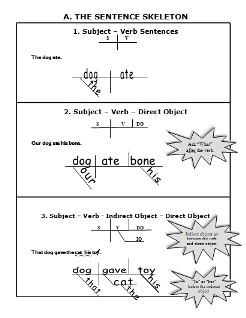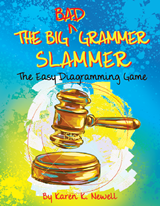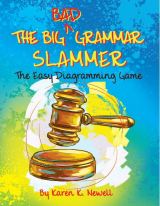English Grammar Tutorial
Need a quick English grammar tutorial? These basic grammar concepts form the lesson plans of The Big Bad Grammar Slammer. Get the FREE Clue Cards download below.
5 Types of Sentences
Module A

The first module provides an English grammar tutorial of the five different types of sentences.
We call these sentences the skeleton of the sentence. All writers must become proficient at writing and recognizing these sentence types.
The good news is that it isn't complicated. If grammar seems like an abstraction with an infinite number of foreign concepts to be learned, students avoid it. But it is encouraging to know that there are only five types of sentences to master.
Lesson 1. Subject - Verb
A dog barked. The child cried. Lightening flashed.
It's really pretty easy stuff.
Lesson 2. Subject - Verb - Direct Object
A fish ate the worm. The student wrote a paper. My mother cooked dinner.
A noun did an action.
Lesson 3. Subject - Verb - Indirect Object - Direct Object
Our aunt gave us an umbrella. The class voted me president.
This is the hardest of the five types of sentences. It's nice to know it's also the least common.
Lesson 4. Subject - Linking Verb - Predicate Nominative
He is a fool. The cat could be a calico. The subject was math.
Instead of an action verb, the verb is one of the "to be" verbs: is, was, may be, would be, am, etc.
Lesson 5. Subject - Linking Verb - Adjective
In these types of sentences, the predicate consists of an adjective or describing word, instead of a noun.
He is foolish. The cat could be dangerous. The subject was difficult.
Speaking of difficult, learning the five types of sentences is not hard. The free clue cards give the student a visual cue to help them remember sentence structure.
Types of Nouns
Module B

The second module of our English grammar tutorial in The Big Bad Grammar Slammer teaches the types of nouns.
The student should already know the definition of a noun:
Person, Place, Thing, or Idea
Another clue: You can put "the" or "a" in front of a noun
Lesson 1. Proper Nouns
Names are proper nouns. They start with capitals. Easy stuff here.
Aunt Alice, Spot, Lord of the Rings, Parrington Park, Christmas Day
Lesson 2. Compound Nouns
There is more than one. The word "and" is most often used, but other conjunctions can be used as well.
- Sally and Tom are friends.
- Homework includes math and spelling.
- You can get a DVD or a video game.
Takes the place of a noun: he, she, it, they, them, we, you.
You have been using personal pronouns long before you could spell pronoun. The only trick is to remember there must be an antecedent.
A what? An antecedent is an indication given previously of who the "he" or "she" might be.
Lesson 4. Infinitives
To be ignorant is unwise.
It's not as complicated as it sounds. An infinitive is a "to be" verb or phrase used as a noun.
I want to be rich and famous. Wow! That's an infinitive with compound adejectives.
Lesson 5. Gerunds
This is a verbal phrase ending with "ing" that is used as a noun. An example is easier than the definition:
Searching for fame leads to ruin.
"Searching for fame" looks like a verb, but it is used as a noun in this sentence.
Granted, most people don't want to run around using the words "gerunds" and "infinitives" in their day to day vocabulary, but we need to use them in order to convey meaningful or complex information.
Lesson 6. Relative Clause
You use these all the time. It's a clause that begins with a relative pronoun: who, whose, whoever, which, whichever, that.
- Whoever left this mess is in trouble.
- I cook whatever customers eat.
Adjectives
Module C
 Adjectives describe nouns. When diagramming sentences, an adjective hangs below the noun.
Adjectives describe nouns. When diagramming sentences, an adjective hangs below the noun. For students who have done the first two modules of The Big Bad Grammar Slammer, these concepts will be familiar.
The clue cards provide visual cues so students can retain the information. Free download below.
Lesson 1. Simple Adjectives
The tiny baby...
The painful bruise...
The scary movie...
Lesson 2. Prepositional Phrases
Students are given a list of all the prepositions in thegrammar tutorial so they don't have to memorize them.
The bird in the nest is chirping. The clouds on the horizon are grey.
Lesson 3. Compound Adjectives
Adjectives are easy and fun.
Compound adjectives are like compound nouns:
- There are more than one
- They have a conjunction (and,or)
Lesson 4. Participial Phrases
This is verb-like word, usually ending in "ing", that is used as an adjective.
It might seem a little complex. Participial phrases are often used by story tellers:
Looking over his shoulder, Tommy quickly took a cookie from the cookie jar.
In this case, "looking over his shoulder" is a verb-looking phrase that is used as an adjective because it describes Tommy.
Lesson 5. Relative Clauses
For the students who completed Module B, the relative pronouns and relative clauses are mere review.
These are relative clauses beginning with: who, which, whoever, that.
A relative clause which is an adjective is a relative clause which describes a noun: The man who is lurking in the shadows has a gun.
Our English grammar tutorial also gives students the differences between a clause and a phrase. Good writers know the difference!
Verb Tenses
Module D
 Caution: Verb tenses can make you tense.
Caution: Verb tenses can make you tense.We have been asked by students why we include these tricky little tenses in our English grammar tutorial, when the rest of The Big Bad Grammar Slammer is easy and practical.
Our answer is that tenses are actually practical. Don't worry about memorizing the names of all these tenses (unless you are studying Latin or Greek. Then you must learn them.)
But for most of us, learning how to manipulate verbs through verb tenses is essential to communicate meaning. It's like knowing what the meaning of "is" is.
How about a better example:
When her brother arrived, he found Anna had been wiping blood from the floor.
A good writer (and a good detective) can see the difference between that sentence and the next one:
When her brother arrived, he found Anna had wiped blood from the floor.
So let's sharpen your grammar and detective skills by noting the five types of verb tenses below.
Lesson 1. Present-Perfect Progressive
As her brother arrives, he finds Anna has been wiping blood from the floor.
PRESENT: happening now
PERFECT: "has" or "have" in the verb phrase
PROGRESSIVE: a continuous action (the difference between "She wipes." and "She is wiping.")
Lesson 2. Past Perfect Simple
When her brother arrived, he found Anna had wiped the blood from the floor.
PAST: action occured in the past
PERFECT: You have that "has" "had" or "have" again.
SIMPLE: single action that is once and done
Lesson 3. Past Perfect Progressive
As her brother arrived, he found Anna had been wiping blood from the floor.
Using the same reasoning, we find:
PAST: action occured in the past
PERFECT: "had" is needed as the past tense of "have"
PROGRESSIVE: an action that starts at one point and progresses to another, requiring the "ing"
Lesson 4. Future Perfect Simple
When her brother arrives, Anna will have wiped blood from the floor.
FUTURE: action takes place in the future
PERFECT: "have" is included
SIMPLE: action is once and done
Lesson 5. Future Perfect Progressive
When her brother arrives, he found Anna will have been wiping blood from the floor.
FUTURE: a future action
PERFECT: there is the "have" again
PROGRESSIVE: a continuous action with the "ing" participle
Yes, I know it sounds complicated, but it really isn't. There are nuances of meaning in the different verb tenses that clarify when the action took place. Writers need that detail to make their meaning clear to the reader, just like Anna needs a good explanation to give to the jury.
Using Adverbs
Module E

Lesson 1. Simple Adverbs
Adverbs modify verbs: The horse ran quickly.
Our English grammar tutorial in The Big Bad Grammar Slammer teaches to diagram each adverb by attaching a line under the word or phrase it modifies.
Lesson 2. Prepositional Phrases as Adverbs
Once your know what a preposition phrase is and what an adverb is, it is easy to write an adverbial prepositional phrase. The horse ran through the gate.
Lesson 3. Adverbs Modifying Adverbs
Adverbs modify other adverbs: The horse ran very quickly.
Lesson 4. Adverbs Modifying Adjectives
Adverbs modify adjectives: The dark brown horse ran. (Of course you realized that "brown" was an adjective modifying the noun "horse."
Lesson 5. Complex Prepositional Phrases
The horse ran through the gate and into the street. Now here's your test: Can you identify the five adverbs in this sentence:
The dark brown horse ran very quickly
through the gate and into the street.
Special Sentences
Module F

Simple sentences are easy to diagram. But with the visual Clue Cards and The Big Bad Grammar Slammer tutorial, your students will easily be able to recognize, diagram, punctuate, and write these special kinds of sentences:
Lesson 1. Interjections
Wow, I hate interjections!
Lesson 2. Direct Address
Nellie, a direct address occurs when you speak to someone by name. It is not hard to diagram or punctuate.
Lesson 3. Direct Quote
"When you write a direct quote," she explained, "you have to use quotation marks."
Lesson 4. Interrogative Sentences
You would diagram these two sentences the same:
- Is an interrogative sentence a question?
- An interrogative question is a sentence.
Lesson 5. Appositives
An appositive, which is a word or phrase that further explains a noun, is separated with commas. It is diagrammed on the same line as the noun but with parenthesis around it.
You can download the Clue Cards below to make these special sentences easier to understand.
Compound and Complex Sentences
Module G
 We now come to the part of the English grammar tutorial that brings all the lessons together and assists the student to tackle the most difficult complicated sentences.
We now come to the part of the English grammar tutorial that brings all the lessons together and assists the student to tackle the most difficult complicated sentences.Unlike other grammar texts, this part of The Big, Bad Grammar Slammer is extremely practical. It teaches the student how to write and analyze the kinds of sentences that actually communicate real information.
We teach grammar using simple sentences because they are easier to use. But most likely, you have not spoken ten simple sentences today. We communicate most frequently with complex and compound sentences.
But students fear writing or diagramming these sentences. Those fears will be forever conquered with this grammar curriculum.
Lesson 1. Comma Conjunction with a Compound Sentence
Two clauses that are both complete sentences can be combined with a conjunction and a comma. This is called the comma-conjunction rule. It makes it easy to remember how to punctuate these sentences.
He likes shrimp, but she likes steak.
Lesson 2. Compound Sentence with a Semicolon
Instead of using a comma and conjunction, two independent sentences can be combined with a semicolon to create a compound sentence. This is done when the meaning of the two sentences are closely connected.
He likes shrimp; she likes steak.
Lesson 3. Complex Sentence with a comma
Complex sentences are more common than compound sentences. In a complex sentence, one clause cannot function as an independent sentence (or independent clause.) The Big Bad Grammar Slammer goes into humorous detail in determining the difference.
Even though he likes shrimp, she made steak.
Lesson 4. Complex Sentence without a comma
The order of the clauses in a complex sentence determines whether or not a comma is needed. Sound complex? We guarantee when the student has written three compound sentences and three complex sentences with this curriculum they will have the concept mastered. See the clue cards to see how easy it really is.
She made steak even though he likes shrimp.
Lesson 5. The Compound/Complex Sentence
Here's the granddaddy of all sentences. Students will have fun constructing these sentences. The more they manipulate clauses and phrases to produce the complex-compound sentence, the stronger their writing skills will become.
Even though he prefers shrimp, she made steak and served it to all his guests.
Download the Clue Cards


Click the image to go to the download.
Or, you can order the entire curriculum below.
Order Grammar Slammer

Order the Soft Bound Edition
- Non-consumable, 5th to 12th grade
- 8 1/2 x 11" Paperback
- 110 pages
- Mailed to your home
- Instructor's Guide included
E-Book Download
- Save time! Print the download from your own computer.
- The same content as the paperback edition.
- 110 pages - Check your printer paper supply.
About Our Site
Hands-On Learning













